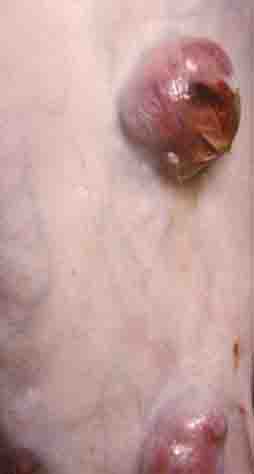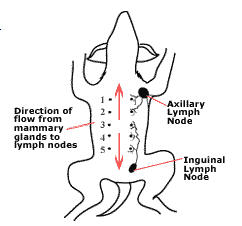Treating Dog Breast Cancer and Canine Mammary Tumors
All canine breeds are a risk for dog breast cancer. Luckily, dogs that are spayed have a reduced incidence of the disease. It is the most common type of tumor in unspayed females, representing 41.7% of all tumors. In countries where spaying does not take place at an early age, it is one of the major causes of death in dogs. When tumors are found in unspayed female dogs, 40% to 50% are malignant or cancerous.
Mammary Tumors in Dogs
Breast cancer is a common problem in females that were not spayed. These neoplasms or tumors can be fast growing (metastic) or small nodules. If found early, and treated when a diagnosis is reached, a more serious health problem can be averted.

Dog Breast Cancer or Mammary Tumors
Source: Washington State University/Dr. Barbar Stein
Canine Breast Cancer Risk Factors
The primary risk factors for dog breast cancer are being unspayed, female, having a genetic risk, and being age 5 to 10. If a dog is treated with hormones, it can also increase the risk. Dogs older than 10 that are diagnosed, usually have benign tumors (not cancerous).
It is rare to find the disease in dogs under age 2. Males can get the diseases, but this happens infrequently. When it does, unfortunately the prognosis for males is poor.
When a female is spayed before the first heat, the risk is practically eliminated. The risk drops to only .05% of the population. In dogs spayed after the first heat, the risk increases to 8%, and to 26% if spayed after the second heat. Researchers believe that spaying reduces the levels of teh progesterone and estrogen hormones, leading to a reduced disease incidence.
Labrador Retrievers are not at high risk for the disease. Dogs that are predisposed include larger breeds such as German Shepherds, Brittany Spaniels, English Setters and German Shepherds.
Types of Dog Breast Tumors
There are several varieties of mammary tumors in dogs. About 1/3 of all neoplasms (another name for tumor) are benign or not dangerous. The faster growing dangerous type are called malignant. If suspected, a veterinarian will recommend that a tissue sample be obtained via a biopsy and then examined via a histopathology.
Often a benign canine mammary tumor contains several types of cells. This type of tumor is rare and is called a benign mixed mammary tumor that is comprised of connective and glandular tissue. Benign dog breast tumors may also be referred to as complex fibroadenomas, adenomas, duct papillomas and simple adenomas.
A canine mammary tumor can be a solid mass or manifest as multiple swellings in the breast. The tumors are often easy to find by palpitating or touching the breast area. At first they will feel like pea sized bumps under the skin. If they grow, they will expand 2x in as short as every 30 days.
Location of Dog Mammary Tumors
A female has 5 mammary glands and nipples, located on the left and right side of the lower abdomen. Dog mammary cancer more frequently appears in the 4th and 5th gland. In 50% of cases, a growth is seen in more than one gland.
Canine Breast Cancer Symptoms
Symptoms vary if the tumors are benign or malignant:
- Benign Dog Breast Cancer: If the bump is benign or not cancerous, the tumor doesn't grow as fast, is smooth and small.
- Malignant Dog Breast Cancer: The more dangerous malignant tumors grow quickly, are irregular in shape, and feel firmly attached under to on the skin. Other symptoms of malignant dog breast tumors include ulceration and bleeding.
Beyond the tumors, the cancer can spread to other parts of the body through the lymph system. The first three mammary glands (1,2,3) will spread cancer to the axillary lymph nodes (right side of the dog's body), while 3,4 and 5 spread to the inguinal lymph nodes (left side of the dog's body). From there, tumors may take hold in the kidneys, liver or lungs.
A rare type of cancer, canine inflammatory mammary carcinoma, may show symptoms such as sudden pain and glandular swelling.

Canine Breast Cancer Diagnosis
In general, touching or looking at a tumor doesn't lead to a definitive diagnosis. Only a skin sample taken via a biopsy will do that. If the vet determines that the tumor should be removed, surgical removal and the biopsy will occur at the same time. Up to 70% of intact female dogs are diagnosed with more than one tumor.
X-Rays will also show if the cancer has spread to the lungs or surrounding lymph nodes. Blood work will also help the Veterinarian understand the extent or stage of the disease.
All of these diagnostic approaches will attempt to determine the stage of the disease based on the tumor size, lymph not status and if the cancer has spread.

Source: Canine Mammary Tumors: Clinical Features, Diagnostics and Staging by Karin U. Sorenmo, DVM, Dept. of Clinical Studies, Veterinary Hospital of the University of Pennsylvania
Dog Breast Cancer Treatment
There area several canine mammary cancer treatment options:
- Surgery: Veterinarian's will first determine if a tumor can be easily removed via surgery. If the neoplasm is caught early, surgery eliminates the malignancy in 50% of cases. If the Vet suspects that the cancer spread, the surgeon might remove the tumor as well as nearby connected lymph nodes.
For instance, if a tumor is found in mammary gland #2 on the left, the surgeon may also remove connected glands #1,2,3 and the axillary lymph nodes. Tumors located in glad 4 on the right would result in the removal of glands #3,4,5 and the inguinal lymph node.
If a dog sarcoma is diagnosed, the it may be too difficult to remove the tumor or the Veterinarian may believe that the tumor may regrow, even if removed.
Note that canine mammary surgery in a dog is nothing like a radical mastectomy in people. No muscle is removed in dogs, making it a simpler operation. Canine recovery after surgery is 10 to 14 days, at which time the dog can resume a normal routine.
Depending on the veterinarian, if a female isn't spayed, this might take place at the same time. Research isn't clear on this point as to whether it is necessary. - Radiation and Chemotherapy: Chemotherapy is not frequently used to treat canine breast cancer. Oncologists are continually trialing new approaches, so be sure to look up the latest protocols. In studies, the 2 year survival of dogs treated with the agents 5-fluouracil and cyclophosphamide was 100%.
Treating dog breast cancer with radiation is also under investigation. - Medications: Some researchers believe that anti-hormone therapy may help to treat the disease, although like chemotherapy and radiation, there is no clear protocol at this time.
Canine Mammary Cancer Prevention
As mentioned above, the best way to prevent canine breast cancer is by spaying a female dog before the first heat. Even spaying after the first heat lowers the risk vs. dogs that were not spayed.
Always check your dog for breast cancer lumps and visit a veterinarian as soon as you suspect a problem. Early treatment will have a significantly better outcome and cost less. If you want to provide an added level of protection, it can't hurt to boost your dog's immune system with a homeopathic such as dog. This is not a cure, but a supplement that combines ingredients thought to improve cellular health.
Have a Canine Cancer Related Question for our Veterinarian?
Ask your dog cancer question and our Veterinarian will answer it for FREE! Just fill out this form and our Vet will get back to you as soon as possible.
Please include information such as the sex, medical history, medications, changes in behavior, when symptoms first appeared and anything else you believe would be helpful. If it makes sense, please send a picture to help us understand the problem better.
Questions are answered on a first come, first served basis and may take some time depending on the number we receive. If you have an urgent question, we suggest using this low cost online veterinary question service that has Vets standing by 24 hours a day, 7 days a week to help.
What Other Visitors Have Asked our Vet and Related Answers about Cancer in Dogs
Click below to see contributions from other visitors to this page...
Tumor Growth on Dog Nipple 




My dog has his left nipple#1 with an out growth, there is not a palpable mass within the breast tissue, no painful. He is 6 years old, lab mix. I am sending …
Chocolate Lab Mammary Cancer Not rated yet
My lab is 5 years old. She had a check up in June which was routine. No problems were identified.
I noticed a lump in an area along the 4th nipple a …
Dog Nipple Bleeding Not rated yet
I have a chocolate lab puppy who will be three in a few months and I just noticed that two of her nipples have dried blood around them and I'm really not …
Related Information:
Dog Breast Cancer References:
Guide to Canine Cancer, the Dog Health Handbook
How I Treat Canine Mammary Gland Tumors
Kenneth M. Rassnick, DVM
College of Veterinary Medicine, Cornell University
Canine Mammary Tumors: Clinical
Features, Diagnostics and Staging
Karin U. Sorenmo, DVM
Dept. of
Clinical Studies, Veterinary Hospital of the University of Pennsylvania
From Treating Dog Breast Cancer to Labrador Retriever Guide Home Page